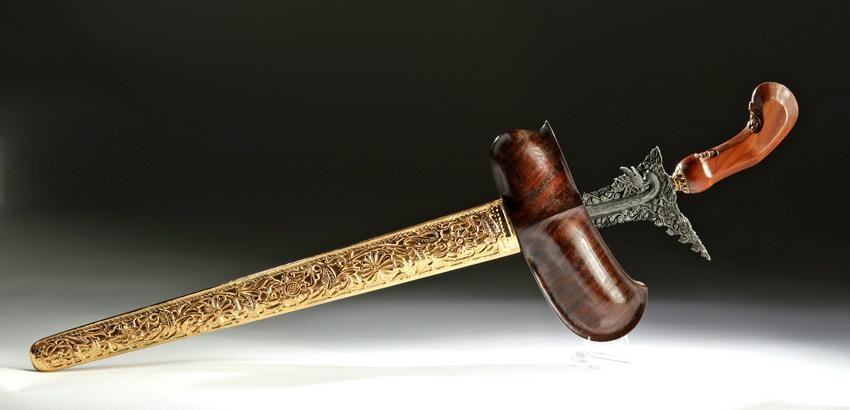20th C. Indonesian Iron Kris w/ Wood, Gilding
Southeast Asia, Indonesia, ca. first half of the 20th century CE. A beautiful example of a personal ceremonial sword known as kris (keris). The hand-carved wooden handle exhibits a pair of abstract anthropomorphic faces along the interior curve, and a gilded brass spacer disc is inlaid with twelve faceted diamonds. The gorgeous cast-iron blade has a serpentine profile, bands of lighter nickel material, and an intricate guard area which resembles an open-mouth naga serpent. The wooden sheath has a bulbous guard protector as well as a gilded brass sheath jacket which dense foliate motifs in repousse. Size (w/ sheath): 6.75" W x 20.3" H (17.1 cm x 51.6 cm); length of blade: 14.5" L (36.8 cm)
The kris is both a weapon and a spiritual object. The oldest known are from the 10th century CE; they are thought to have originated on the island of Java. The bladesmith, called an empu, formed the blade from layers of different iron ores and meteorite nickel. In high-quality examples, the metal is folded dozens or even hundreds of times. Kris were worn every day and in special ceremonies; both men and women wear them. They were passed down through families. They were used for display, as talismans with magical powers, and weapons, and as heirlooms, as accessories for ceremonial dress, and indicators of social status. Kris blades are narrow, with wide, symmetrical bases. The aesthetic value has three elements: dhapur, the shape and design of the blade, with 40 variants; pamor, the pattern of metal alloy decoration on the blade, with 120 variants; and tangguh, the age and origin of kris. In 2005, the kris became a UNESCO Masterpiece of the Oral and Intangible Heritage of Humanity.
Provenance: private Rochester, Michigan, USA collection
All items legal to buy/sell under U.S. Statute covering cultural patrimony Code 2600, CHAPTER 14, and are guaranteed to be as described or your money back.
A Certificate of Authenticity will accompany all winning bids.
We ship worldwide to most countries and handle all shipping in-house for your convenience.
#138034
Condition Report: GILDED BRASS jacket is adhered to sheath and cannot be removed. Minor nicks to blade and guard, with light abrasions to handle and sheath, otherwise intact and excellent. Light earthen deposits and fine patina throughout.
View it on
Estimate
Time, Location
Auction House
Southeast Asia, Indonesia, ca. first half of the 20th century CE. A beautiful example of a personal ceremonial sword known as kris (keris). The hand-carved wooden handle exhibits a pair of abstract anthropomorphic faces along the interior curve, and a gilded brass spacer disc is inlaid with twelve faceted diamonds. The gorgeous cast-iron blade has a serpentine profile, bands of lighter nickel material, and an intricate guard area which resembles an open-mouth naga serpent. The wooden sheath has a bulbous guard protector as well as a gilded brass sheath jacket which dense foliate motifs in repousse. Size (w/ sheath): 6.75" W x 20.3" H (17.1 cm x 51.6 cm); length of blade: 14.5" L (36.8 cm)
The kris is both a weapon and a spiritual object. The oldest known are from the 10th century CE; they are thought to have originated on the island of Java. The bladesmith, called an empu, formed the blade from layers of different iron ores and meteorite nickel. In high-quality examples, the metal is folded dozens or even hundreds of times. Kris were worn every day and in special ceremonies; both men and women wear them. They were passed down through families. They were used for display, as talismans with magical powers, and weapons, and as heirlooms, as accessories for ceremonial dress, and indicators of social status. Kris blades are narrow, with wide, symmetrical bases. The aesthetic value has three elements: dhapur, the shape and design of the blade, with 40 variants; pamor, the pattern of metal alloy decoration on the blade, with 120 variants; and tangguh, the age and origin of kris. In 2005, the kris became a UNESCO Masterpiece of the Oral and Intangible Heritage of Humanity.
Provenance: private Rochester, Michigan, USA collection
All items legal to buy/sell under U.S. Statute covering cultural patrimony Code 2600, CHAPTER 14, and are guaranteed to be as described or your money back.
A Certificate of Authenticity will accompany all winning bids.
We ship worldwide to most countries and handle all shipping in-house for your convenience.
#138034
Condition Report: GILDED BRASS jacket is adhered to sheath and cannot be removed. Minor nicks to blade and guard, with light abrasions to handle and sheath, otherwise intact and excellent. Light earthen deposits and fine patina throughout.



